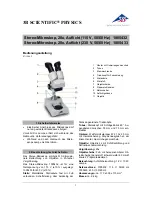
6
COMPONENTS OF THE STEREO MICROSCOPE
BOTTOM ILLUMINATOR – The light source that is mounted in the
base to provide trans-illumination.
DIOPTER ADJUSTMENT – Located on the left eyepiece tube (SM90)
or left and right eye tubes (M28Z/M29TZ). This adjustment is used
to fine focus the optics to compensate for visual differences
between the user’s eyes.
EYEPIECE – The upper optical element that further magnifies the
primary image of the specimen and brings the light rays in focus at
the eyepoint.
EYEPIECE TUBE – The part of the head that holds the eyepieces in
place. Set screws in the eyepiece tubes can be used to lock the
eyepieces in place.
STAGE CLIP – Used to hold specimen in place.
FOCUSING CONTROL KNOB – The focusing control knobs located on
either side of the stand are used to raise or lower the head to bring
the specimen into focus. The control knobs incorporate a slip
clutch system which prevents the head from traveling past both
ends of the focusing range. When the focusing limit is reached, the
clutch system begins to slip to prevent gear damage.
HEAD – The 360˚ rotatable component that contains all of the
optical elements of the stereo microscope including the eyepieces,
refracting prisms and objective lenses. The head of the SM90 series
and M28Z / M29TZ is designed to allow users to adjust the
interpupillary distance of the eyepieces for proper viewing.
ILLUMINATOR DIMMER CONTROL – The intensity of the top
(incident light) LED or bottom (trans-illumination) LED can be
adjusted to the preferred brightness (0 through 9) by using the
dimmer control located on the side of the base.
ILLUMINATOR ON/OFF SWITCHES – A tri-illumination system is
incorporated into the stand. The illumination system is controlled
by top (incident light) and bottom (trans-illumination) on/off
switches located at the base of the stand. The incident illuminator
is used for opaque specimens, while the trans-illuminator
effectively illuminates the internal structure of transparent
specimens. Translucent specimens may be seen in greater detail if
both illuminators are used simultaneously.






























